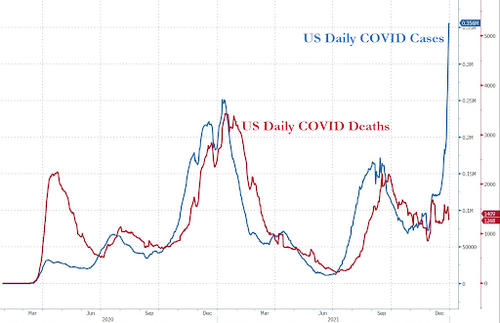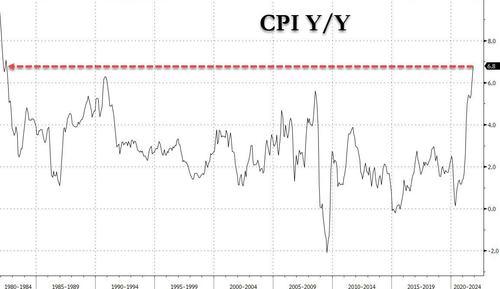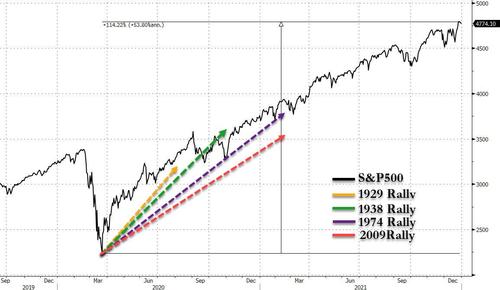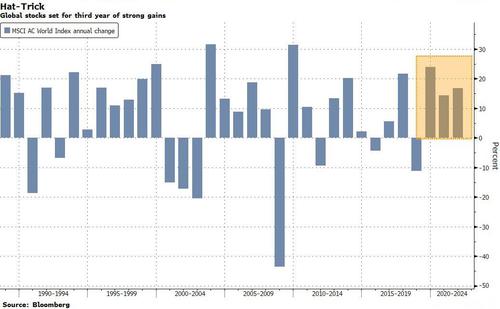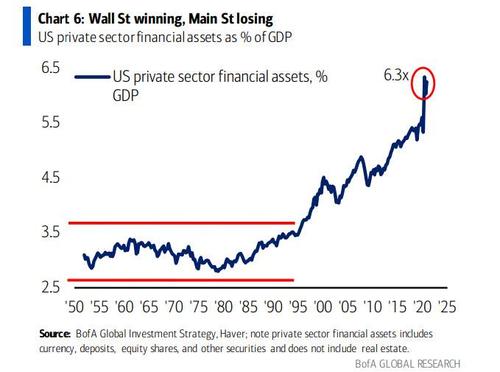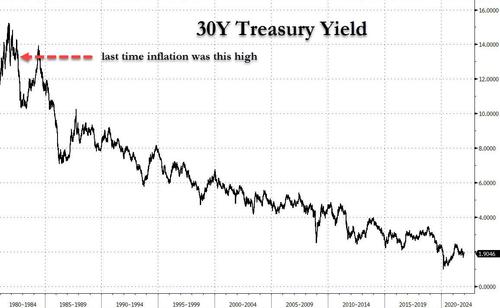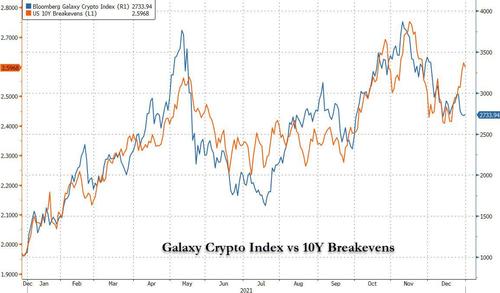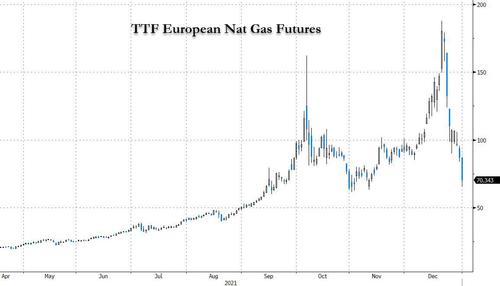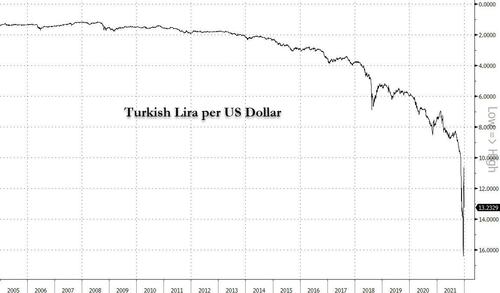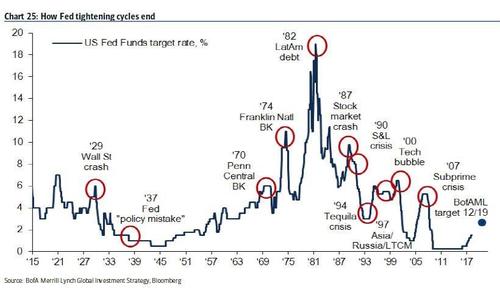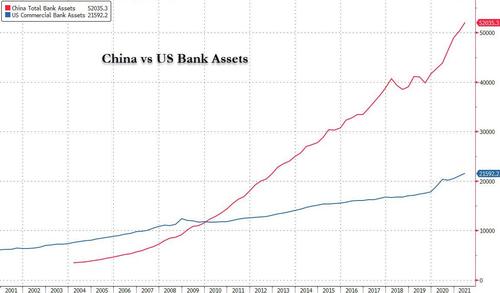2021 Greatest Hits: The Most Popular Articles Of The Past Year And A Look Ahead
One year ago, when looking at the 20 most popular stories of 2020, we said that the year would be a very tough act to follow as there “could not have been more regime shifts, volatility moments, and memes than 2020.” And yet despite the exceedingly high bar for 2021, the year did not disappoint and proved to be a successful contender, and if judging by the sheer breadth of narratives, stories, surprises, plot twists and unexpected developments, 2021 was even more memorable and event-filled than 2020.
Where does one start?
While covid was the story of 2020, the pandemic that emerged out of a (Fauci-funded) genetic lab team in Wuhan, China dominated newsflow, politics and capital markets for the second year in a row. And while the biggest plot twist of 2020 was Biden’s victory over Trump in the presidential election (it took the pandemic lockdowns and mail-in ballots to hand the outcome to Biden), largely thanks to Covid, Biden failed to hold to his biggest presidential promise of defeating covid, and not only did he admit in late 2021 that there is “no Federal solution” to covid waving a white flag of surrender less than a year into his presidency, but following the recent emergence of the Xi, pardon Omicron variant, the number of covid cases in the US has just shattered all records.
The silver lining is not only that deaths and hospitalizations have failed to follow the number of cases, but that the scaremongering narrative itself is starting to melt in response to growing grassroots discontent with vaccine after vaccine and booster after booster, which by now it is clear, do nothing to contain the pandemic. And now that it is clear that omicron is about as mild as a moderate case of the flu, the hope has finally emerged that this latest strain will finally kill off the pandemic as it becomes the dominant, rapidly-spreading variant, leading to worldwide herd immunity thanks to the immune system’s natural response. Yes, it may mean billions less in revenue for Pfizer and Moderna, but it will be a colossal victory for the entire world.
The second biggest story of 2021 was undoubtedly the scourge of soaring inflation, which contrary to macrotourist predictions that it would prove “transitory”, refused to do so and kept rising, and rising, and rising, until it hit levels not seen since the Volcker galloping inflation days of the 1980s. The only difference of course is that back then, the Fed Funds rate hit 20%. Now it is at 0%, and any attempts to hike aggressively will lead to a horrific market crash, something the Fed knows very well.
Whether this was due to supply-chain blockages and a lack of goods and services pushing prices higher, or due to massive stimulus pushing demand for goods – and also prices – higher, or simply the result of a record injection of central bank liquidity into the system, is irrelevant but what does matter is that it got so bad that even Biden, facing a mauling for his Democratic party in next year’s midterm elections, freaked out about soaring prices and pushed hard to lower the price of gasoline, ordering releases from the US Strategic Petroleum Reserve and vowing to punish energy companies that dare to make a profit, while ordering Powell to contain the surge in prices even if means the market is hit. Unfortunately for Biden, the market will be hit even as inflation still remain red hot for much of the coming year.
And speaking of markets, while 2022 may be a year when the piper finally gets paid, 2021 was yet another blockbuster year for risk assets, largely on the back of the continued global response to the 2020 covid pandemic, when as we wrote last year, we saw “the official arrival of global Helicopter Money, tens of trillions in fiscal and monetary stimulus, an overhaul of the global economy punctuated by an unprecedented explosion in world debt, an Orwellian crackdown on civil liberties by governments everywhere, and ultimately set the scene for what even the World Economic Forum called simply “The Great Reset.”
Yes, the staggering liquidity injections that started in 2020, continued throughout 2021 and the final tally is that after $3 trillion in emergency liquidity injections in the immediate aftermath of the pandemic to stabilize the world, the Fed injected almost $2 trillion in the subsequent period, of which $1.5 trillion in 2021, a year where economists were “puzzled” why inflation was soaring. This, of course, excludes the tens of trillions of monetary stimulus injected by other central banks as well as the boundless fiscal stimulus that was greenlighted with the launch of helicopter money (i.e., MMT) in 2020.
It’s also why with inflation running red hot and real rates the lowest they have ever been, everyone was forced to rush into the “safety” of stocks (or stonks as they came to be known among GenZ), and why after last year’s torrid stock market returns, the S&P rose another 27% in 2021 and up a staggering 114% from the March 2020 lows, in the process trouncing all previous mega-rallies (including those in 1929, 1938, 1974 and 2009)…
… making this the third consecutive year of double-digit returns.
This reminds us of something we said last year: “it’s almost as if the world’s richest asset owners requested the covid pandemic.” A year later, we got confirmation for this rhetorical statement, when we calculated that in the 18 months since the covid pandemic, the richest 1% of US society have seen their net worth increase by over $30 trillion. As a result, the US is now officially a banana republic where the middle 60% of US households by income – a measure economists use as a definition of the middle class – saw their combined assets drop from 26.7% to 26.6% of national wealth as of June, the lowest in Federal Reserve data, while for the first time the super rich had a bigger share, at 27%. Yes, the 1% now own more wealth than the entire US middle class, a definition traditionally reserve for kleptocracies and despotic African banana republics.
It wasn’t just the rich, however: politicians the world over would benefit from the transition from QE to outright helicopter money and MMT which made the over monetization of deficits widely accepted in the blink of an eye.
The common theme here is simple: no matter what happens, capital markets can never again be allowed to drop, regardless of the cost or how much more debt has to be incurred. Indeed, as we look back at the news barrage over the past year, and past decade for that matter, the one thing that becomes especially clear amid the constant din of markets, of politics, of social upheaval and geopolitical strife – and now pandemics – in fact a world that is so flooded with constant conflicting newsflow and changing storylines that many now say it has become virtually impossible to even try to predict the future, is that despite the people’s desire for change, for something original and untried, the world’s established forces will not allow it and will fight to preserve the broken status quo at any price – even global coordinated shutdowns – which is perhaps why it always boils down to one thing – capital markets, that bedrock of Western capitalism and the “modern way of life”, where control, even if it means central planning the likes of which have not been seen since the days of the USSR, and an upward trajectory must be preserved at all costs, as the alternative is a global, socio-economic collapse.
And since it is the daily gyrations of stocks that sway popular moods the interplay between capital markets and politics has never been more profound or more consequential.
The more powerful message here is the implicit realization and admission by politicians, not just Trump who had a penchant of tweeting about the S&P every time it rose, but also his peers on both sides of the aisle, that the stock market is now seen as the consummate barometer of one’s political achievements and approval. Which is also why capital markets are now, more than ever, a political tool whose purpose is no longer to distribute capital efficiently and discount the future, but to manipulate voter sentiments far more efficiently than any fake Russian election interference attempt ever could.
Which brings us back to 2021 and the past decade, which was best summarized by a recent Bill Blain article who said that “the last 10-years has been a story of massive central banking distortion to address the 2008 crisis. Now central banks face the consequences and are trapped. The distortion can’t go uncorrected indefinitely.“
He is right: the distortion will eventually collapse especially if the Fed follows through with its attempt rate hikes some time in mid-2020, but so far the establishment and the “top 1%” have been successful – perhaps the correct word is lucky – in preserving the value of risk assets: on the back of the Fed’s firehose of liquidity the S&P500 returned an impressive 27% in 2021, following a 15.5% return in 2020 and 28.50% in 2019. It did so by staging the greatest rally off all time from the March lows, surpassing all of the 4 greatest rallies off the lows of the past century (1929,1938, 1974, and 2009).
Yet this continued can-kicking by the establishment – all of which was made possible by the covid pandemic and lockdowns which served as an all too convenient scapegoat for the unprecedented response that served to propel risk assets (and fiat alternatives such as gold and bitcoin) to all time highs – has come with a price… and an increasingly higher price in fact. As even Bank of America CIO Michael Hartnett admits, Fed’s response to the the pandemic “worsened inequality” as the value of financial assets – Wall Street – relative to economy – Main Street – hit all-time high of 6.3x.
And while the Fed was the dynamo that has propelled markets higher ever since the Lehman collapse, last year certainly had its share of breakout moments. Here is a sampling.
-
Gamestop and the emergence of meme stonks and the daytrading apes: In January markets were hypnotized by the massive trading volumes, rolling short squeezes and surging share prices of unremarkable established companies such as consoles retailer GameStop and cinema chain AMC and various other micro and midcap names. What began as a discussion on untapped value at GameStop on Reddit months earlier by Keith Gill, better known as Roaring Kitty, morphed into a hedge fund-orchestrated, crowdsourced effort to squeeze out the short position held by a hedge fund, Melvin Capital. The momentum flooded through the retail market, where daytraders shunned stocks and bought massive out of the money calls, sparking rampant “gamma squeezes” in the process forcing some brokers to curb trading. Robinhood, a popular broker for day traders and Citadel’s most lucrative “subsidiary”, required a cash injection to withstand the demands placed on it by its clearing house. The company IPOed later in the year only to see its shares collapse as it emerged its business model was disappointing hollow absent constant retail euphoria. Ultimately, the market received a crash course in the power of retail investors on a mission. Ultimately, “retail favorite” stocks ended the year on a subdued note as the trading frenzy from earlier in the year petered out, but despite underperforming the S&P500, retail traders still outperformed hedge funds by more than 100%.
-
Failed seven-year Treasury auction: Whereas auctions of seven-year US government debt generally spark interest only among specialists, on on February 25 2021, one such typically boring event sparked shockwaves across financial markets, as the weakest demand on record hit prices across the whole spectrum of Treasury bonds. The five-, seven- and 10-year notes all fell sharply in price. Researchers at the Federal Reserve called it a “flash event”; we called it a “catastrophic, tailing” auction, the closest thing the US has had to a failed Trasury auction. The flare-up, as the FT put it, reflects one of the most pressing investor concerns of the year: inflation. At the time, fund managers were just starting to realize that consumer price rises were back with a vengeance — a huge threat to the bond market which still remembers the dire days of the Volcker Fed when inflation was about as high as it is today but the 30Y was trading around 15%. The February auaction also illustrated that the world’s most important market was far less liquid and not as structurally robust as investors had hoped. It was an extreme example of a long-running issue: since the financial crisis the traditional providers of liquidity, a group of 24 Wall Street banks, have pulled back because of higher costs associated with post-2008 capital requirements, while leaving liquidity provision to the Fed. Those banks, in their reduced role, as well as the hedge funds and high-frequency traders that have stepped into their place, have tended to withdraw in moments of market volatility. Needless to say, with the Fed now tapering its record QE, we expect many more such “flash” episodes in the bond market in the year ahead.
-
The arch ego of Archegos: In March 2021 several banks received a brutal reminder that some of family offices, which manage some $6 trillion in wealth of successful billionaires and entrepreneurs and which have minimal reporting requirements, take risks that would make the most serrated hedge fund manager wince, when Bill Hwang’s Archegos Capital Management imploded in spectacular style. As we learned in late March when several high-flying stocks suddenly collapsed, Hwang – a former protege of fabled hedge fund group Tiger Management – had built up a vast pile of leverage using opaque Total Return Swaps with a handful of banks to boost bets on a small number of stocks (the same banks were quite happy to help despite Hwang’s having been barred from US markets in 2013 over allegations of an insider-trading scheme, as he paid generously for the privilege of borrowing the banks’ balance sheet). When one of Archegos more recent bets, ViacomCBS, suddenly tumbled it set off a liquidation cascade that left banks including Credit Suisse and Nomura with billions of dollars in losses. Conveniently, as the FT noted, the damage was contained to the banks rather than leaking across financial markets, but the episode sparked a rethink among banks over how to treat these clients and how much leverage to extend.
-
The second coming of cryptos: After hitting an all time high in late 2017 and subsequently slumping into a “crypto winter”, cryptocurrencies enjoyed a huge rebound in early 2021 which sent their prices soaring amid fears of galloping inflation (as shown below, and contrary to some financial speculation, the crypto space has traditionally been a hedge either to too much liquidity or a hedge to too much inflation). As a result, Bitcoin rose to a series of new record highs that culminated at just below $62,000, nearly three times higher than their previous all time high. But the smooth ride came to a halt in May when China’s crackdown on the cryptocurrency and its production, or “mining”, sparked the first serious crash of 2021. The price of bitcoin then collapsed as much as 30% on May 19, hitting a low of $30,000 amid a liquidation of levered positions in chaotic trading conditions following a warning from Chinese authorities of tighter curbs ahead. A public acceptance by Tesla chief and crypto cheerleader Elon Musk of the industry’s environmental impact added to the declines. However, as with all previous crypto crashes, this one too proved transitory, and prices resumed their upward trajectory in late September when investors started to price in the launch of futures-based bitcoin exchange traded funds in the US. The launch of these contracts subsequently pushed bitcoin to a new all-time high in early November before prices stumbled again in early December, this time due to a rise in institutional ownership when an overall drop in the market dragged down cryptos as well. That demonstrated the growing linkage between Wall Street and cryptocurrencies, due to the growing sway of large investors in digital markets.
-
China’s common prosperity crash: China’s education and tech sectors were one of the perennial Wall Street darlings. Companies such as New Oriental, TAL Education as well as Alibaba and Didi had come to be worth billions of dollars after highly publicized US stock market flotations. So when Beijing effectively outlawed swaths of the country’s for-profit education industry in July 2021, followed by draconian anti-trust regulations on the country’s fintech names (where Xi Jinping also meant to teach the country’s billionaire class a lesson who is truly in charge), the short-term market impact was brutal. Beijing’s initial measures emerged as part of a wider effort to make education more affordable as part of president Xi Jinping’s drive for “common prosperity” but that quickly raised questions over whether growth prospects across corporate China are countered by the capacity of the government to overhaul entire business models overnight. Sure enough, volatility stemming from the education sector was soon overshadowed by another set of government reforms related to common prosperity, a crackdown on leverage across the real estate sector where the biggest casualty was Evergrande, the world’s most indebted developer. The company, whose boss was not long ago China’s 2nd richest man, was engulfed by a liquidity crisis in the summer that eventually resulted in a default in early December. Still, as the FT notes, China continues to draw in huge amounts of foreign capital, pushing the Chinese yuan to end 2021 at the strongest level since May 2018, a major hurdle to China’s attempts to kickstart its slowing economy, and surely a precursor to even more monetary easing.
-
Natgas hyperinflation: Natural gas supplanted crude oil as the world’s most important commodity in October and December as prices exploded to unprecedented levels and the world scrambled for scarce supplies amid the developed world’s catastrophic transition to “green” energy. The crunch was particularly acute in Europe, which has become increasingly reliant on imports. Futures linked to TTF, the region’s wholesale gas price, hit a record €137 per megawatt hour in early October, rising more than 75%. In Asia, spot liquefied natural gas prices briefly passed the equivalent of more than $320 a barrel of oil in October. (At the time, Brent crude was trading at $80). A number of factors contributed, including rising demand as pandemic restrictions eased, supply disruptions in the LNG market and weather-induced shortfalls in renewable energy. In Europe, this was aggravated by plunging export volumes from Gazprom, Russia’s state-backed monopoly pipeline supplier, amid a bitter political fight over the launch of the Nordstream 2 pipeline. And with delays to the Nord Stream 2 gas pipeline from Russia to Germany, analysts say the European gas market – where storage is only 66% full – a cold snap or supply disruption away from another price spike
-
Turkey’s (latest) currency crisis: As the FT’s Jonathan Wheatley writes, Recep Tayyip Erdogan was once a source of strength for the Turkish lira, and in his first five years in power from 2003, the currency rallied from TL1.6 per US dollar to near parity at TL1.2. But those days are long gone, as Erdogan’s bizarre fascination with unorthodox economics, namely the theory that lower rates lead to lower inflation also known as “Erdoganomics”, has sparked a historic collapse in the: having traded at about TL7 to the dollar in February, it has since fallen beyond TL17, making it the worst performing currency of 2021. The lira’s defining moment in 2021 came on November 18 when the central bank, in spite of soaring inflation, cut its policy rate for the third time since September, at Erdogan’s behest (any central banker in Turkey who disagrees with “Erdoganomics” is promptly fired and replaced with an ideological puppet). The lira recovered some of its losses in late December when Erdogan came up with the “brilliant” idea of erecting the infamous “doom loop” which ties Turkey’s balance sheet to its currency. It has worked for now (the lira surged from TL18 against the dollar to TL12, but this particular band aid solution will only last so long). The lira’s problems are not only Erdogan’s doing. A strengthening dollar, rising oil prices, the relentless covid pandemic and weak growth in developing economies have been bad for other emerging market currencies, too, but as long as Erdogan is in charge, shorting the lira remains the best trade entering 2022.
While these, and many more, stories provided a diversion from the boring existence of centrally-planned markets, we are confident that the trends observed in recent years will continue: coming years will be marked by even bigger government (because only more government can “fix” problems created by government), higher stock prices and dollar debasement (because only more Fed intervention can “fix” the problems created by the Fed), and a policy flip from monetary and QE to fiscal & MMT, all of which will keep inflation at scorching levels, much to the persistent confusion of economists everywhere.
Of course, we said much of this last year as well, but while we got most trends right, we were wrong about one thing: we were confident that China’s aggressive roll out of the digital yuan would be a bang – or as we put it “it is very likely that while 2020 was an insane year, it may prove to be just an appetizer to the shockwaves that will be unleashed in 2021 when we see the first stage of the most historic overhaul of the fiat payment system in history” – however it turned out to be a whimper. A big reason for that was that the initial reception of the “revolutionary” currency was nothing short of disastrous, with Chinese admitting they were “not at all excited” about the prospect of yet one more surveillance mechanism for Beijing, because that’s really what digital currencies are: a way for central banks everywhere to micromanage and scrutinize every single transaction, allowing the powers that be to demonetize any one person – or whole groups – with the flick of a switch.
Then again, while digital money may not have made its triumphant arrival in 2021, we are confident that the launch date has merely been pushed back to 2022 when the rollout of the next monetary revolution is expected to begin in earnest.
Here we should again note one thing: in a world undergoing historic transformations, any free press must be throttled and controlled, and over the past year we have seen unprecedented efforts by legacy media and its corporate owners, as well as the new “social media” overlords do everything in their power to stifle independent thought. For us it had been especially “personal” on more than one occasions. Last January, Twitter suspended our account because we dared to challenge the conventional narrative about the source of the Wuhan virus. It was only six months later that Twitter apologized, and set us free, admitting it had made a mistake.
Yet barely had twitter readmitted us, when something even more unprecedented happened: for the first time ever (to our knowledge) Google – the world’s largest online ad provider and monopoly – demonetized our website not because of any complaints about our writing but because of the contents of our comment section. It then held us hostage until we agreed to implement some prerequisite screening and moderation of the comments section. Google’s action was followed by the likes of PayPal, Amazon, and many other financial and ad platforms, who rushed to demonetize and suspend us simply because they disagreed with what we had to say.
This was a stark lesson in how quickly an ad-funded business can disintegrate in this world which resembles the dystopia of 1984 more and more each day, and we have since taken measures. One year ago, for the first time in our 13 year history, we launched a paid version of our website, which is entirely ad and moderation free, and offers readers a variety of premium content. It wasn’t our intention to make this transformation but unfortunately we know which way the wind is blowing and it is only a matter of time before the gatekeepers of online ad spending block us again. As such, if we are to have any hope in continuing it will come directly from you, our readers. We will keep the free website running for as long as possible, but we are certain that it is only a matter of time before the hammer falls as the censorship bandwagon rolls out much more aggressively in the coming year.
That said, whether the story of 2022, and the next decade for that matter, is one of helicopter or digital money, of (hyper)inflation or deflation: what is key, and what we learned in the past decade, is that the status quo will throw anything at the problem to kick the can, it will certainly not let any crisis go to waste… even the deadliest pandemic in over a century. And while many already knew that, the events of 2021 made it clear to a fault that not even a modest market correction can be tolerated going forward. After all, if central banks aim to punish all selling, then the logical outcome is to buy everything, and investors, traders and speculators did just that armed with the clearest backstop guarantee from the Fed, which in the deapths of the covid crash crossed the Rubicon when it formally nationalized the bond market as it started buying both investment grade bonds and junk bond ETFs in the open market. As such it is no longer even a debatable issue if the Fed will buy stocks after the next crash – the only question is when.
Meanwhile, for all those lamenting the relentless coverage of politics in a financial blog, why finance appears to have taken a secondary role, and why the political “narrative” has taken a dominant role for financial analysts, the past year showed vividly why that is the case: in a world where markets gyrated, and “rotated” from value stocks to growth and vice versa, purely on speculation of how big the next stimulus out of Washington will be, the narrative over Biden’s trillions proved to be one of the biggest market moving events for much of the year. And with the Biden stimulus plan off the table for now, the Fed will find it very difficult to tighten financial conditions, especially if it does so just as the economy is slowing. Here we like to remind readers of one of our favorite charts: every financial crisis is the result of Fed tightening.
As for predictions about the future, as the past two years so vividly showed, when it comes to actual surprises and all true “black swans”, it won’t be what anyone had expected. And so while many themes, both in the political and financial realm, did get some accelerated closure courtesy of China’s covid pandemic, dramatic changes in 2021 persisted, and will continue to manifest themselves in often violent and unexpected ways – from the ongoing record polarization in the US political arena, to “populist” upheavals around the developed world, to the gradual transition to a global Universal Basic (i.e., socialized) Income regime, to China’s ongoing fight with preserving stability in its gargantuan financial system which is now two and a half times the size of the US.
As always, we thank all of our readers for making this website – which has never seen one dollar of outside funding (and despite amusing recurring allegations, has certainly never seen a ruble from the KGB either, although now that the entire Russian hysteria episode is over, those allegations have finally quieted down), and has never spent one dollar on marketing – a small (or not so small) part of your daily routine.
Which also brings us to another critical topic: that of fake news, and something we – and others who do not comply with the established narrative – have been accused of. While we find the narrative of fake news laughable, after all every single article in this website is backed by facts and links to outside sources, it is clearly a dangerous development, and a very slippery slope that the entire developed world is pushing for what is, when stripped of fancy jargon, internet censorship under the guise of protecting the average person from “dangerous, fake information.” It’s also why we are preparing for the next onslaught against independent thought and why we had no choice but to roll out a premium version of this website.
In addition to the other themes noted above, we expect the crackdown on free speech to accelerate in the coming year when key midterm elections will be held, especially as the following list of Top 20 articles for 2021 reveals, many of the most popular articles in the past year were precisely those which the conventional media would not touch out of fear of repercussions, which in turn allowed the alternative media to continue to flourish in an orchestrated information vacuum and take significant market share from the established outlets by covering topics which the public relations arm of established media outlets refused to do, in the process earning itself the derogatory “fake news” condemnation.
We are grateful that our readers – who hit a new record high in 2021 – have realized it is incumbent upon them to decide what is, and isn’t “fake news.”
* * *
And so, before we get into the details of what has now become an annual tradition for the last day of the year, those who wish to jog down memory lane, can refresh our most popular articles for every year during our no longer that brief, almost 11-year existence, starting with 2009 and continuing with 2010, 2011, 2012, 2013, 2014, 2015, 2016, 2017, 2018, 2019 and 2020.
So without further ado, here are the articles that you, our readers, found to be the most engaging, interesting and popular based on the number of hits, during the past year.
-
In 20th spot with 600,000 reads, was an article that touched on one of the most defining features of the market: the reflation theme the sparked a massive rally at the start of the year courtesy of the surprise outcome in the Georgia Senate race, where Democrats ended up wining both seats up for grabs, effectively giving the Dems a majority in both the House and the Senate, where despite the even, 50-seat split, Kamala Harris would cast the winning tie-breaker vote to pursue a historic fiscal stimulus. And sure enough, as we described in “Bitcoin Surges To Record High, Stocks & Bonds Battered As Dems Look Set To Take Both Georgia Senate Seats“, with trillions in “stimmies” flooding both the economy and the market, not only did retail traders enjoy unprecedented returns when trading meme “stonks” and forcing short squeezes that crippled numerous hedge funds, but expectations of sharply higher inflation also helped push bitcoin and the entire crypto sector to new all time highs, which in turn legitimized the product across institutional investors and helped it reach a market cap north of $3 trillion.
-
In 19th spot, over 613,000 readers were thrilled to read at the start of September that “Biden Unveils Most Severe COVID Actions Yet: Mandates Vax For All Federal Workers, Contractors, & Large Private Companies.” Of course, just a few weeks later much of Biden’s mandate would be struck down in courts, where it is now headed to a decision by SCOTUS, while the constantly shifting “scientific” goal posts mean that just a few months later the latest set of CDC regulations have seen regulators and officials reverse the constant drone of fearmongering and are now even seeking to cut back on the duration of quarantine and other lockdown measures amid a public mood that is growing increasingly hostile to the government response.
-
One of the defining political events of 2021 was the so-called “Jan 6 Insurrection“, which the for America’s conservatives was blown wildly out of proportion yet which the leftist media and Democrats in Congress have been periodically trying to push to the front pages in hopes of distracting from the growing list of failures of the Obama admin. Yet as we asked back in January, “Why Was Founder Of Far-Left BLM Group Filming Inside Capitol As Police Shot Protester?” No less than 614,000 readers found this question worthy of a response. Since then many more questions have emerged surrounding this event, many of which focus on what role the FBI had in organizing and encouraging this event, including the use of various informants and instigators. For now, a response will have to wait at least until the mid-term elections of 2022 when Republicans are expected to sweep one if not both chambers.
-
Linked to the above, the 17th most read article of 2021 with 617,000 views, was an article we published on the very same day, which detailed that “Armed Protesters Begin To Arrive At State Capitols Around The Nation.” At the end of the day, it was much ado about nothing and all protests concluded peacefully and without incident: perhaps the FBI was simply spread too thin?
-
2021 was a year defined by various waves of the covid pandemic which hammered poor Americans forced to hunker down at home and missing on pay, and crippled countless small mom and pop businesses. And yet, it was also a bonanza for a handful of pharma companies such as Pfizer and Moderna which made billions from the sale of “vaccines” which we now know do little if anything to halt the spread of the virus, and are instead now being pitched as palliatives, preventing a far worse clinical outcome. The same pharma companies also benefited from an unconditional indemnity, which surely would come in useful when the full side-effects of their mRNA-based therapies became apparent. One such condition to emerge was myocarditis among a subset of the vaxxed. And while the vaccines continue to be broadly rolled out across most developed nations, one place that said enough was Sweden. As over 620,000 readers found out in “Sweden Suspends Moderna Shot Indefinitely After Vaxxed Patients Develop Crippling Heart Condition“, not every country was willing to use its citizens as experimental guniea pigs. This was enough to make the article the 16th most read on these pages, but perhaps in light of the (lack of) debate over the pros and cons of the covid vaccines, this should have been the most read article this year?
-
Moving on to the 15th most popular article, 628,000 readers were shocked to learn that “Chase Bank Cancels General Mike Flynn’s Credit Cards.” The action, which was taken by the largest US bank due to “reputational risk” echoed a broad push by tech giants to deplatform and silence dissenting voices by literally freezing them out of the financial system. In the end, following widespread blowback from millions of Americans, JPMorgan reversed, and reactivated Flynn’s cards saying the action was made in error, but unfortunately this is just one example of how those in power can lock out any dissenters with the flick of a switch. And while democrats cheer such deplatforming today, the political winds are fickle, and we doubt they will be as excited once they find themselves on the receiving end of such actions.
-
And speaking of censorship and media blackouts, few terms sparked greater response from those in power than the term Ivermectin. Viewed by millions as a cheap, effective alternative to offerings from the pharmaceutical complex, social networks did everything in their power to silence any mention of a drug which the Journal of Antibiotics said in 2017 was an “enigmatic multifaceted ‘wonder’ drug which continues to surprise and exceed expectations.” Nowhere was this more obvious than in the discussion of how widespread use of Ivermectin beat Covid in India, the topic of the 14th most popular article of 2021 “India’s Ivermectin Blackout” which was read by over 653,000 readers. Unfortunately, while vaccines continue to fail upward and now some countries are now pushing with a 4th, 5th and even 6th vaccine, Ivermectin remains a dirty word.
-
There was more covid coverage in the 13th most popular article of 2021, “Surprise Surprise – Fauci Lied Again”: Rand Paul Reacts To Wuhan Bombshell” which was viewed no less than 725,000 times. Paul’s reaction came following a report which revealed that Anthony Fauci’s NIAID and its parent, the NIH, funded Gain-of-Function research in Wuhan, China, strongly hinting that the emergence of covid was the result of illicit US funding. Not that long ago, Fauci had called Paul a ‘liar’ for accusing him of funding the risky research, in which viruses are genetically modified or otherwise altered to make them more transmissible to humans. And while we could say that Paul got the last laugh, Fauci still remains Biden’s top covid advisor, which may explain why one year after Biden vowed he would shut down the pandemic, the number of new cases just hit a new all time high. One hope we have for 2022 is that people will finally open their eyes…
-
2021 was not just about covid – soaring prices and relentless inflation were one of the most poignant topics. It got so bad that Biden’s approval rating – and that of Democrats in general – tumbled toward the end of the year, putting their mid-term ambitions in jeopardy, as the public mood soured dramatically in response to the explosion in prices. And while one can debate whether it was due to supply-issues, such as the collapse in trans-pacific supply chains and the chronic lack of labor to grow the US infrastructure, or due to roaring demand sparked by trillions in fiscal stimulus, but when the “Big Short” Michael Burry warned that hyperinflation is coming, the people listened, and with over 731,000 reads, the 12th most popular article of 2021 was “Michael Burry Warns Weimar Hyperinflation Is Coming.” Of course, Burry did not say anything we haven’t warned about for the past 12 years, but at least he got the people’s attention, and even mainstream names such as Twitter founder Jack Dorsey agreed with him, predicting that bitcoin will be what is left after the dollar has collapsed. While hyperinflation may will be the endgame, the question remains: when.
-
For the 11th most read article of 2021, we go back to a topic touched upon moments ago when we addressed the full-blown media campaign seeking to discredit Ivermectin, in this case via the D-grade liberal tabloid Rolling Stone (whose modern incarnation is sadly a pale shadow of the legend that house Hunter S. Thompson’s unforgettable dispatches) which published the very definition of fake news when it called Ivermectin a “horse dewormer” and claimed that, according to a hospital employee, people were overdosing on it. Just a few hours later, the article was retracted as we explained in “Rolling Stone Issues ‘Update’ After Horse Dewormer Hit-Piece Debunked” and over 812,000 readers found out that pretty much everything had been a fabrication. But of course, by then it was too late, and the reputation of Ivermectin as a potential covid cure had been further tarnished, much to the relief of the pharma giants who had a carte blanche to sell their experimental wares.
-
The 10th most popular article of 2021 brings us to another issue that had split America down the middle, namely the story surrounding Kyle Rittenhouse and the full-blown media campaign that declared the teenager guilty, even when eventually proven innocent. Just days before the dramatic acquittal, we learned that “FBI Sat On Bombshell Footage From Kyle Rittenhouse Shooting“, which was read by over 822,000 readers. It was unfortunate to learn that once again the scandal-plagued FBI stood at the center of yet another attempt at mass misinformation, and we can only hope that one day this “deep state” agency will be overhauled from its core, or better yet, shut down completely. As for Kyle, he will have the last laugh: according to unconfirmed rumors, his numerous legal settlements with various media outlets will be in the tens if not hundreds of millions of dollars.
-
And from the great US social schism, we again go back to Covid for the 9th most popular article of 2021, which described the terrifying details of one of the most draconian responses to covid in the entire world: that of Australia. Over 900,000 readers were stunned to read that the “Australian Army Begins Transferring COVID-Positive Cases, Contacts To Quarantine Camps.” Alas, the latest surge in Australian cases to nosebleed, record highs merely confirms that this unprecedented government lockdown – including masks and vaccines – is nothing more than an exercise in how far government can treat its population as a herd of sheep without provoking a violent response.
-
The 8th most popular article of 2021 looks at the market insanity of early 2021 when, at the end of January, we saw some of the most-shorted, “meme” stocks explode higher as the Reddit daytrading horde fixed their sights on a handful of hedge funds and spent billions in stimmies in an attempt to force unprecedented ramps. That was the case with “GME Soars 75% After-Hours, Erases Losses After Liquidity-Constrained Robinhood Lifts Trading Ban“, which profiled the daytrading craze that gave an entire generation the feeling that it too could win in these manipulated capital markets. Then again, judging by the waning retail interest, it is possible that the excitement of the daytrading army is fading as rapidly as it first emerged, and that absent more “stimmies” markets will remain the playground of the rich and central banks.
-
Kyle Rittenhouse may soon be a very rich man after the ordeal he went through, but the media’s mission of further polarizing US society succeeded, and millions of Americans will never accept that the teenager was innocent. It’s also why with just over 1 million reads, the 7th most read article on Zero Hedge this year was that “Portland Rittenhouse Protest Escalates Into Riot.” Luckily, this is not a mid-term election year and there were no moneyed interests seeking to prolong this particular riot, unlike what happened in the summer of 2020… and what we are very much afraid will again happen next year when very critical elections are on deck.
-
With just over 1.03 million views, the 6th most popular post focused on a viral Twitter thread on Friday from Dr Robert Laone, which laid out a disturbing trend; the most-vaccinated countries in the world are experiencing a surge in COVID-19 cases, while the least-vaccinated countries were not. As we originally discussed in “”This Is Worrying Me Quite A Bit”: mRNA Vaccine Inventor Shares Viral Thread Showing COVID Surge In Most-Vaxxed Countries“, this trend has only accelerated in recent weeks with the emergence of the Omicron strain. Unfortunately, instead of engaging in a constructive discussion to see why the science keeps failing again and again, Twitter’s response was chilling: with just days left in 2021, it suspended the account of Dr. Malone, one of the inventors of mRNA technology. Which brings to mind something Aaron Rogers said: “If science can’t be questioned it’s not science anymore it’s propaganda & that’s the truth.“
-
In a year that was marked a flurry of domestic fiascoes by the Biden administration, it is easy to forget that the aged president was also responsible for the biggest US foreign policy disaster since Vietnam, when the botched evacuation of Afghanistan made the US laughing stock of the world after 12 US servicemembers were killed. So it’s probably not surprising that over 1.1 million readers were stunned to watch what happened next, which we profiled in the 5th most popular post of 2021, where in response to the Afghan trajedy, “Biden Delivers Surreal Press Conference, Vows To Hunt Down Isis, Blames Trump.” One person watching the Biden presser was Xi Jinping, who may have once harbored doubts about reclaiming Taiwan but certainly does not any more.
-
The 4th most popular article of 2021 again has to do with with covid, and specifically the increasingly bizarre clinical response to the disease. As we detailed in “Something Really Strange Is Happening At Hospitals All Over America” while emergency rooms were overflowing, it certainly wasn’t from covid cases. Even more curiously, one of the primary ailments leading to an onslaught on ERs across the nation was heart-related issues, whether arrhytmia, cardiac incidents or general heart conditions. We hope that one day there will be a candid discussion on this topic, but until then it remains one of the topics seen as taboo by the mainstream media and the deplatforming overlords, so we’ll just leave it at that.
-
We previously discussed the anti-Ivermectin narrative that dominated the mainstream press throughout 2021 and the 3rd most popular article of the year may hold clues as to why: in late September, pharma giant Pfizer and one of the two companies to peddle an mRNA based vaccine, announced that it’s launching an accelerated Phase 2/3 trial for a COVID prophylactic pill designed to ward off COVID in those may have come in contact with the disease. And, as we described in “Pfizer Launches Final Study For COVID Drug That’s Suspiciously Similar To ‘Horse Paste‘,” 1.75 million readers learned that Pfizer’s drug shared at least one mechanism of action as Ivermectin – an anti-parasitic used in humans for decades, which functions as a protease inhibitor against Covid-19, which researchers speculate “could be the biophysical basis behind its antiviral efficiency.” Surely, this too was just another huge coincidence.
-
In the second most popular article of 2021, almost 2 million readers discovered (to their “shock”) that Fauci and the rest of Biden’s COVID advisors were proven wrong about “the science” of COVID vaccines yet again. After telling Americans that vaccines offer better protection than natural infection, a new study out of Israel suggested the opposite is true: natural infection offers a much better shield against the delta variant than vaccines, something we profiled in “This Ends The Debate’ – Israeli Study Shows Natural Immunity 13x More Effective Than Vaccines At Stopping Delta.” We were right about one thing: anyone who dared to suggest that natural immunity was indeed more effective than vaccines was promptly canceled and censored, and all debate almost instantly ended. Since then we have had tens of millions of “breakout” cases where vaccinated people catch covid again, while any discussion why those with natural immunity do much better remains under lock and key.
-
It may come as a surprise to many that the most read article of 2021 was not about covid, or Biden, or inflation, or China, or even the extremely polarized US congress (and/or society), but was about one of the most long-suffering topics on these pages: precious metals and their prices. Yes, back in February the retail mania briefly targeted silver and as millions of reddit daytraders piled in in hopes of squeezing the precious metal higher, the price of silver surged higher only to tumble just as quickly as it has risen as the seller(s) once again proved more powerful than the buyers. We described this in “Silver Futures Soar 8%, Rise Above $29 As Reddit Hordes Pile In“, an article which some 2.4 million gold and silver bugs read with hope, only to see their favorite precious metals slump for much of the rest of the year. And yes, the fact that both gold and silver ended the year sharply lower than where they started even though inflation hit the highest level in 40 years, remains one of the great mysteries of 2021.
With all that behind us, and as we wave goodbye to another bizarre, exciting, surreal year, what lies in store for 2022, and the next decade?
We don’t know: as frequent and not so frequent readers are aware, we do not pretend to be able to predict the future and we don’t try despite endless allegations that we constantly predict the collapse of civilization: we leave the predicting to the “smartest people in the room” who year after year have been consistently wrong about everything, and never more so than in 2021 (even the Fed admitted it is clueless when Powell said it was time to retire the term “transitory“), which destroyed the reputation of central banks, of economists, of conventional media and the professional “polling” and “strategist” class forever, not to mention all those “scientists” who made a mockery of the “expertise class” with their bungled response to the covid pandemic. We merely observe, find what is unexpected, entertaining, amusing, surprising or grotesque in an increasingly bizarre, sad, and increasingly crazy world, and then just write about it.
We do know, however, that after a record $30 trillion in stimulus was conjured out of thin air by the world’s central banks and politicians in the past two years, the attempt to reverse this monetary and fiscal firehose in a world addicted to trillions in newly created liquidity now that central banks are freaking out after finally getting ot the inflation they were hoping to create for so long, will end in tears.
We are confident, however, that in the end it will be the very final backstoppers of the status quo regime, the central banking emperors of the New Normal, who will eventually be revealed as fully naked. When that happens and what happens after is anyone’s guess. But, as we have promised – and delivered – every year for the past 13, we will be there to document every aspect of it.
Finally, and as always, we wish all our readers the best of luck in 2022, with much success in trading and every other avenue of life. We bid farewell to 2021 with our traditional and unwavering year-end promise: Zero Hedge will be there each and every day – usually with a cynical smile – helping readers expose, unravel and comprehend the fallacy, fiction, fraud and farce that defines every aspect of our increasingly broken system.
Tyler Durden
Fri, 12/31/2021 – 13:44
via ZeroHedge News https://ift.tt/31d7ut5 Tyler Durden
